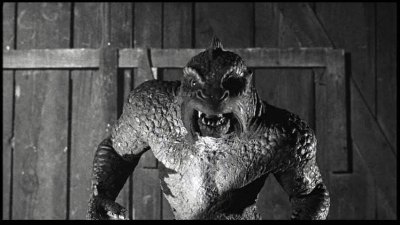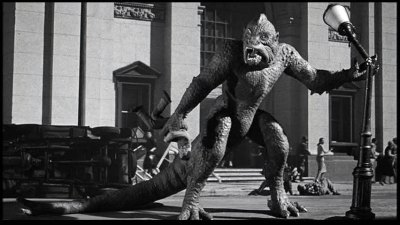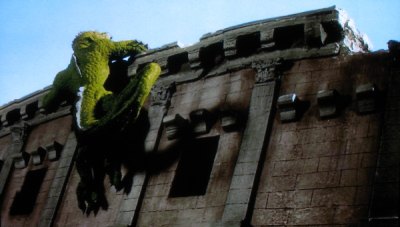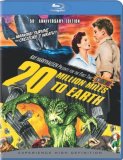| Reviews & Columns |
|
Reviews DVD TV on DVD Blu-ray 4K UHD International DVDs In Theaters Reviews by Studio Video Games Features Collector Series DVDs Easter Egg Database Interviews DVD Talk Radio Feature Articles Columns Anime Talk DVD Savant Horror DVDs The M.O.D. Squad Art House HD Talk Silent DVD
|
DVD Talk Forum |
|
|
| Resources |
|
DVD Price Search Customer Service #'s RCE Info Links |
|
Columns
|
|
|
20 Million Miles To Earth
Ray Harryhausen was one of the first special effects super-stars. A student of Willis H. O'Brien (the man who brought King Kong to life), he took stop-motion animation to the next level; creating creatures that moved and acted like they were real. After working with O'Brien on Mighty Joe Young (1949), Harryhausen struck out on his own. His first big film was Warner Brothers The Beast from 20,000 Fathoms (1953). He then teamed up with producer Charles H. Schneer at Columbia and started a partnership that would last years. Their first picture together was It Came from Beneath the Sea (1955) which was a hit. They followed that up with one of the 50's best alien invasion films, Earth vs. the Flying Saucers (1956), which also did well. For their third film together, Harryhausen wanted a movie that would really showcase what he could do. The result is 20 Million Miles to Earth, a film where Harryhausen, at the peak of his creative powers, elevates stop motion animation to an art form. This Blu-ray disc presents the restored film in both colorized and original B&W versions and comes with a copious amount of bonus features.
 Off the coast of Sicily, some fishermen witness an American spaceship crash into the ocean. The only survivor is Col. Robert Calder (William Hopper of Perry Mason fame) who was the leader of the first expedition to Venus. They've brought back with them a specimen of Venusian life; an egg that was lost when the ship sunk into the ocean.
Off the coast of Sicily, some fishermen witness an American spaceship crash into the ocean. The only survivor is Col. Robert Calder (William Hopper of Perry Mason fame) who was the leader of the first expedition to Venus. They've brought back with them a specimen of Venusian life; an egg that was lost when the ship sunk into the ocean.
Only it wasn't. The container with the egg washed ashore and the young boy who finds it sells his unusual find to a local zoologist, Dr. Leonardo (Frank Puglia). The doctor is amazed when the unique egg hatches and a small, bipedal creature is born. In Earth's atmosphere the creature, Ymir, (though his name is never mentioned in the movie itself) grows at a fantastic rate. Starting out a foot high, the creature is as big as a man the next morning and keeps growing from there.
Dr. Leonardo realizes that he has to take his find to Rome, but on the way it escapes. The US Space agency is looking for it too, and with the Italian government behind them they track and finally capture Ymir, but it's hard to keep a good monster caged for long.
 This is a fun film when Ymir is on the screen. The creature has facial expressions, moves in a realistic fashion, and looks like it could be really wandering around the Italian countryside. The animation is so well done that it looks like a real monster, not like a puppet or some guy in a suit, as just about all other creature films from the time did.
This is a fun film when Ymir is on the screen. The creature has facial expressions, moves in a realistic fashion, and looks like it could be really wandering around the Italian countryside. The animation is so well done that it looks like a real monster, not like a puppet or some guy in a suit, as just about all other creature films from the time did.
The problems start when Ymir isn't on the screen. The actors range from average (Hopper and his romantic interest Joan Taylor) to down-right awful (everybody else.) The Italian boy who finds the container washed up on the shore was supposed to be comic relief, rambling on and on about cowboys in America, but instead ends up being one of the most irritating kids in a SF film.
While the plot of the film was rather straight forward and pretty standard, catch the monster that is impervious to bullets, there is an interesting subtext to the film. Ymir is passive. He's only aggressive when attacked and isn't even a carnivore. The monster just wants to be left alone yet the humans keeps attacking and harassing him. The actions he takes to defend himself seem very reasonable. In the end it's the inhabitants of Earth who seem more monstrous than the tall, muscular visitor from Venus.
The Blu-ray Disc:
Video:
This disc offers viewers the choice of screening the movie either in the original black and white, or a colorized version of the film. "Colorized? Wasn't that practice all but abandoned 15 years ago?" I hear you ask. No, there are still some people who think that an artificially tinted film is superior to the original black and white. Several Shirley Temple films have been colorized recently, and so has 20 Million Miles to Earth.
 The colorization was done under the supervision of Ray Harryhausen, and in the commentary track he says that he's very pleased with the results. He also notes that the film was originally intended to be in color, but budgetary restraints forced them to shoot it in black and white. How does it look? It looks very good for a colorized film. Which is like saying the people in Toy Story look good for a computer animated film. In both cases the studios did a solid job, but just as you'll never mistake Sid in Toy Story for a real person, you won't think that this film was actually shot in color.
The colorization was done under the supervision of Ray Harryhausen, and in the commentary track he says that he's very pleased with the results. He also notes that the film was originally intended to be in color, but budgetary restraints forced them to shoot it in black and white. How does it look? It looks very good for a colorized film. Which is like saying the people in Toy Story look good for a computer animated film. In both cases the studios did a solid job, but just as you'll never mistake Sid in Toy Story for a real person, you won't think that this film was actually shot in color.
I thought the colors actually made the film less enjoyable. While it did help some of the scenes, such as when the space ship first crashes and is sticking out of the ocean, there were far more scenes that were marred by the process. While the images have a nice three dimensional property in black and white, the color tends to flatten things out. The scenes appear much more two dimensional. The colors of a soldiers uniform, for example, makes the outfit look like it's all in one plane, instead of being wrapped around a person's body. And while a lot of time was spent getting Ymir to look realistic in color, when he's in the barn the shadows don't play across his skin with the same effect that they do in black and white. That scene doesn't have the same impact in color as it does in the original, and that's too bad.
 I questioned some of the color choices too. The skin tones of the Italians were a little too dark and not entirely realistic and there were some shots where color was added even though there wasn't any color in the original. I've been to Rome and the lovely old stone buildings are brown/gray in color, but for some reason the decision was made make the white window sills blue.
I questioned some of the color choices too. The skin tones of the Italians were a little too dark and not entirely realistic and there were some shots where color was added even though there wasn't any color in the original. I've been to Rome and the lovely old stone buildings are brown/gray in color, but for some reason the decision was made make the white window sills blue.
Happily the original black and white version, cleaned as the first step of the colorization process, is included and it looks great. The 1080p/AVC MPEG-4 encoded image has a very good amount of detail with the scales on Ymir's hide being clear and well defined even in the shadows. The blacks are solid without being crushed and the gray tones have a wide range. Digitally things look just as good. Posterization is absent and there was only the slightest amount of shimmering when the camera panned over fine details. Overall this is an excellent looking movie.
Audio:
This disc comes with a Dolby TrueHD 5.1 soundtrack that sounds very good given its origins. There is no hiss or background noise, which is saying something for a 50 year old film, and the dialog is clean and clear. The mutli-track mix for this disc was created from the original mono track (which is sadly missing), and even though much of the sound is centered on the screen, there is some use of the whole soundstage, especially during the action scenes. When Ymir is fighting the elephant, for example, the sound of the battle pans across the room quite effectively, and even though the elephant's roar sounds phony (the same audio would be used for Pterodactyls on Johnny Quest years later) the mix is quite effective.
Extras:
This Blu-ray disc ports over all of the bonus features that were found in the 2-disc 50th Anniversary edition, though the video extras are presented in SD. The best extra included with this set is the audio commentary with Ray Harryhausen as well as producer Arnold Kunert and special effects artists Dennis Muren and Phil Tippett. This is a very informative and entertaining track and is sure to please Harryhausen fans. Though Ray is getting on in years and has forgotten many details, he's still able to talk about the filming and creation of the movie as well as some to the problems that were encountered. The track is lively and the four commentators manage to fill up the entire movie without running out of things to say.
Next up is Remembering 20 Million Miles to Earth, a half hour featurette that has Harryhausen talking about his final black and white feature as well as interviews with famous directors who wax poetically about how much the movie influenced them. The Colorization Process shows just how the film was tinted, while Tim Burton Sits Down with Ray Harryhausen is a discussion between the two film greats. This lasts about 27 minutes and it's clear that Burton is a big fan of Rays. Though the interview runs a little long, it was a nice addition.
The films female lead, Joan Taylor is interviewed in she reminisces about the film. Mischa Bakaleinikoff: Movie Music's Unsung Hero looks at the composer's contribution to the film. The package is rounded out with a reproduction of the 20 Million Miles More comic book and a look at the Original Ad Artwork.
Final Thoughts:
Ray Harryhausen would go on to even more impressive projects, but this last black and white film is the one where he really started expanding his reach and pushing his limit to see just how far he could go with stop motion animation. As a movie, the film is excellent when Ymir is on the screen, but only mediocre when the narrative switches over to the humans. Still, it's an enjoyable way to spend some time and this Blu-ray disc makes the film look great. Recommended.
Note: The images in this review are not from the Blu-ray disc and do not necessarily represent the image quality on the disc.
|
| Popular Reviews |
| Sponsored Links |
|
|
| Sponsored Links |
|
|
| Release List | Reviews | Shop | Newsletter | Forum | DVD Giveaways | Blu-Ray | Advertise |
|
Copyright 2024 DVDTalk.com All Rights Reserved. Legal Info, Privacy Policy, Terms of Use,
Manage Preferences,
Your Privacy Choices | |||||||













